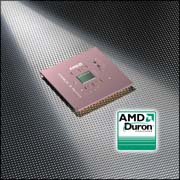|

|
AMD's K6-2 line have always been popular for budget consumers in need of an affordable and fairly quick PC. However, the times they have changed.
90% Rating: 
|
|
|
|
Home >
Reviews >
CPU / Processors >
AMD Duron 1GHz |
|
|
AMD Duron 700 Review
 AMD's K6-2 line
have always been popular for budget consumers in need of an
affordable and fairly quick PC. However the Quake crowd turned away from the
K6-2 because of its lackluster 3D performance. The Celeron processor was the
budget gaming CPU of choice. However, the times they have changed. The
change AMD made was to release the Duron CPU based on their Thunderbird Athlon
design. OEM price for the Duron 700Mhz is $112 CDN / $73 USD AMD's K6-2 line
have always been popular for budget consumers in need of an
affordable and fairly quick PC. However the Quake crowd turned away from the
K6-2 because of its lackluster 3D performance. The Celeron processor was the
budget gaming CPU of choice. However, the times they have changed. The
change AMD made was to release the Duron CPU based on their Thunderbird Athlon
design. OEM price for the Duron 700Mhz is $112 CDN / $73 USD
The Duron is the clear cut winner right now as
the budget CPU of choice. It promises to provide great gaming performance,
as well as strong application performance. The price is also very
attractive, where the Duron 700 is selling for $112 CDN, the Celeron 633
(fastest currently available in Canada,) is still over $160 CDN!
AMD is clearly very confident with the
Duron:
|
Innovative Architecture
With the
introduction of the AMD Duron processor, value-minded buyers now have access to
technology that stands out among that of other processors in its class. Some of
the AMD Duron processor's innovative features include:
- High-Speed System Bus: The AMD Duron processor features a
200MHz front side system bus, offering more available bus bandwidth than that
of Intel's Celeron processor. This high-speed system bus delivers exceptional
performance on data-rich applications, such as MP3 encoders, video encoders,
soft DVD players, and basic video-editing packages.
- Sophisticated Cache Architecture: The AMD
Duron processor features 192K of total on-chip cache. This large on-chip cache
combined with the sophisticated cache architecture, delivers superior
performance in comparison to Intel's Celeron processor on memory-intensive
applications. Such applications include business and personal productivity
suites, as well as basic 3D content creation and photo-editing
packages.
- Superscalar Floating Point Unit with Enhanced 3DNow!"!
Technology: The AMD Duron processor offers three floating
point pipelines while Intel's Celeron processor offers only one. This
outstanding number-crunching capability, in concert with AMD's enhanced
3DNow!"! multimedia technology, enables the AMD Duron processor to deliver
superior performance on applications rich in graphics. Examples of these
applications include web-design tools, as well as entertainment and
'edutainment' products.
The AMD Duron processor's innovative architecture enables it to
handily outperform Intel's Celeron in clock-for-clock comparisons. In fact, the
AMD Duron processor often meets or exceeds performance of Intel's higher-cost
Pentium? III processor in similar clock-for-clock benchmarking tests |
The most important differences between the Duron and the Celeron happen to be the
system bus advantage that the Duron has over the Celeron. Where the Duron has a
100Mhz DDR bus (effectively 200mhz), the Celeron only has a 66Mhz front side
bus. The cache situation also favours the Duron, the Duron has 128KB L1
cache, and 64KB L2 cache, the Celeron has only 32KB L1 cache, and 128KB L2
cache. Both processors have on-die cache, operating at CPU frequency (ie
700Mhz cache bus for the 700Mhz Duron.)
With all of these fancy features, how does this "mighty" CPU perform?
We'll first start with some SiSoft Sandra scores, as well as some Quake III
scores. I believe the Quake III scores will help you to
visualize how quick this CPU is or isn't. I'll follow it up with the
overclocked scores.
Test Machine:
Duron 700 with Global Win FOP cooler (27.2 CFM) fan.
ABIT KT7 RAID Motherboard
2x128MB Infineon PC-133 RAM
Asus V7700 Geforce 2 Video card @ 235Mhz/ 365Mhz
And some other stuff that doesn't really
factor into the benchmarks.
|
|
|
|

